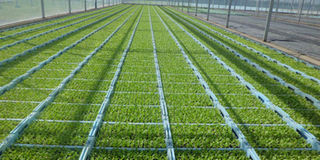Lessons for Ugandan farmers in using mechanised agriculture

Lettuce seedlings in a greenhouse.
What you need to know:
Since the ox plough, use of machinery in farming has evolved a lot. What limits Ugandan farmers from adopting mechanisation?
While farmers in the developed world have been empowered by the use of machinery in their day-to-day activities, those in most of developing world are still practicing rudimentary farming. Yet mechanised agriculture is now being emphasised as the way forward.
Powered machinery has replaced many jobs formerly carried out by manual labour and by animal traction with oxen and horses. But the latter is still useful to most farmers in the developing countries including Uganda.
The history of agriculture contains many examples of tool use. The first prevalent mechanisation of agriculture came with the introduction of the plough, usually powered by animals, but modern methods include the use of tractors, trucks, combine harvesters, airplanes called crop dusters, and unmanned airborne vehicles known as drones. In addition, computers and satellite technology is applied.
High level
In UK, in Cambridge, where farmers are engaged in mechanised farming, Guy Shropshire started his farm for growing salad crops in 1952 such as lettuce, mushrooms, onions, spinach and beetroot, among others. He later formed a company called G’s Growers.
Today, it is one of the leading agribusiness companies in the country marketing the products across the European Union and in America.
G’s Growers also grows the crops both in and outside the UK, in countries such as Spain, Holland, Czech Republic, Portugal, Italy, New Zealand and Senegal but strategises its marketing opportunities in the European Union.
According to the project manager, Mr John Currah, due to the high level of mechanisation, the company is able to effectively plough and manage about 11,451 hectares of land in UK.
They use machines such as automated tractors, seed planters and combined harvesters which uproot the crops from the fields, sort them and package them.
The managing director, in charge of farms, Mr Peter Sargeant, adds that especially in East Anglia, where they are based, there are prolonged dry spells. Therefore, a lot has to be invested in water harvesting and irrigation. “We purchase seeds for all crops we grow from seed companies and propagation of the seedlings is done within the greenhouses, which is done with the blocking line machine,” he said.
About one million plantlets of lettuce seedlings can be produced in one day. Before the seedlings are transferred to the greenhouse, they are blocked in trays and coated with sand to avoid too much moisture.
Minimal time
Using this, 70 trays are blocked per hour, which is 72,000 plantlets per hour in the trays ready for germination. It takes 25 days from blocking to transfer to the field. Lettuce takes three months to mature.
During the planting session, a few workers load a seed planter machine, which does the planting of the seedlings in the vast fields minus a driver operating it.
With mechanised agriculture, such farmers or farming companies cultivate vast chunks of land in minimal time and harvest what is enough to feed the population as well as reap huge yields and earn income.
This is not the same with farmers in Uganda because they are still stuck with the hand hoe and planting and weeding using manual labour.
Dr Lastus Serunjogi Katende, a plant breeder and technical advisor at Cotton Development Organisation, observes Ugandan farmers have a limitation in engaging in large-scale commercial agriculture because they do not practice mechanised agriculture.
“Farmers in developed countries tame their land using machinery like tractors, this helps them prepare the land in time for the next planting season and even remove obstacles like anthills, trees and bushes. But in Uganda, this is done manually, which is time-consuming,” he explains.
When it comes to cereal crops like maize, millet, sorghum, farmers spread the seeds over the land. This becomes a problem during weeding because the plants were not organised in rows.
However, a number of farmers are using ox plough, which is the cheapest and simplest method of mechanisation and a few use tractors but to make harvesting easier, machines like combine harvesters would do a good job.
However, according to Dr Serunjogi, in the 1970s, many farmers were able to use tractors to plough their fields because the agricultural system then was well managed by the Ministry of Agriculture, and they would access them. Now, farmers would have to hire tractors from individuals, which is expensive.
The failure by farmers to mechanise production has led to most of them growing crops on small plots of land. And, in most cases, many plant the crops late leading to effects of drought, pest and diseases. This leads to low yields which affects food security.




